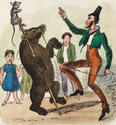 Social dancing was a popular pursuit in Glasgow between the 1770s and 1830s, from informal gatherings, perhaps held in a tavern, to prestigious assemblies, held in custom designed ballrooms. The ability to dance was an essential accomplishment for wealthy Glaswegians, and the complexity of dance forms meant that specialist teachers were in demand. Instruction started young, and in addition to learning the latest London or Paris dance styles, scholars polished their skills in etiquette.
Social dancing was a popular pursuit in Glasgow between the 1770s and 1830s, from informal gatherings, perhaps held in a tavern, to prestigious assemblies, held in custom designed ballrooms. The ability to dance was an essential accomplishment for wealthy Glaswegians, and the complexity of dance forms meant that specialist teachers were in demand. Instruction started young, and in addition to learning the latest London or Paris dance styles, scholars polished their skills in etiquette.
 There were five city dance schools in 1787, at a time when the newly built Tontine building had become Glasgow's most fashionable venue for balls. This status was overtaken when more commodious Assembly Rooms were erected in Ingram Street in 1796. The range of dances was then limited, with preferences for the sedate minuet and robust Scottish reels. However, as the vogue for dancing intensified, new forms emerged. The waltz was regarded as daringly intimate when it was first introduced to Britain around 1812. Yet in Glasgow by 1815 Hamilton's Dance Academy was featuring the waltz as part of its programme.
There were five city dance schools in 1787, at a time when the newly built Tontine building had become Glasgow's most fashionable venue for balls. This status was overtaken when more commodious Assembly Rooms were erected in Ingram Street in 1796. The range of dances was then limited, with preferences for the sedate minuet and robust Scottish reels. However, as the vogue for dancing intensified, new forms emerged. The waltz was regarded as daringly intimate when it was first introduced to Britain around 1812. Yet in Glasgow by 1815 Hamilton's Dance Academy was featuring the waltz as part of its programme.
 Dancing may have been the focus of display among elite society, but there was an appreciation of its exhilarating qualities across all social classes. Scottish country dancing remained a perennial favourite, although the refinements of the dance academies barely influenced the "penny reel" gatherings that were popular at fair-time. By the 1830s local householders were cashing in on the crowds attending Glasgow Fair by making their homes available for dances, a penny a time. Dancing was on its way to becoming a marketable commodity with mass appeal.
Dancing may have been the focus of display among elite society, but there was an appreciation of its exhilarating qualities across all social classes. Scottish country dancing remained a perennial favourite, although the refinements of the dance academies barely influenced the "penny reel" gatherings that were popular at fair-time. By the 1830s local householders were cashing in on the crowds attending Glasgow Fair by making their homes available for dances, a penny a time. Dancing was on its way to becoming a marketable commodity with mass appeal.